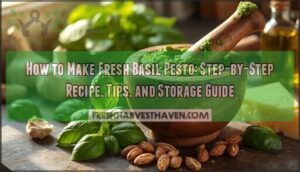This site is supported by our readers. We may earn a commission, at no cost to you, if you purchase through links.
Nothing whispers summer quite like a handful of basil leaves glistening with dew, their scent cutting through the morning quiet. Basil pesto isn’t just a recipe—it’s the fast track to capturing the season’s fullness, every bit as fresh as if you’d just picked it yourself.
The secret lies in how you handle each ingredient, from stripping spotless leaves to coaxing the sharpest notes from garlic and cheese. When you treat every step like it matters, the difference in flavor isn’t subtle.
Let’s get your kitchen smelling like an Italian garden, one bold batch of basil pesto at a time.
Table Of Contents
- Key Takeaways
- How to Make Fresh Basil Pesto
- Essential Ingredients for Basil Pesto
- Preparation Techniques for Perfect Pesto
- Storing and Preserving Fresh Basil Pesto
- Top Products for Making Basil Pesto
- Frequently Asked Questions (FAQs)
- How do you make Basil Pesto in Italy?
- How long does it take to make Basil Pesto?
- How do you make homemade pesto?
- What is basil pesto?
- What to eat with basil pesto?
- Can Basil Pesto be made in advance?
- How to make basil pesto fresh?
- What is the secret to a good pesto?
- Does basil need to be dry before making pesto?
- How long does fresh homemade basil pesto last?
- Conclusion
Key Takeaways
- Fresh basil pesto demands quality ingredients handled with care—harvest basil early in the morning when essential oils peak, dry leaves completely to avoid bitterness, and toast nuts in a dry pan to unlock deeper flavor before blending.
- The secret to restaurant-quality pesto lies in proper technique: pulse ingredients in short bursts to prevent overheating, drizzle oil gradually for smooth emulsion, and blend Parmesan with Pecorino Romano to balance nutty richness with sharp tang.
- Preserving pesto’s vibrant green color requires smart storage—blanch basil for 15 seconds to lock in chlorophyll, layer olive oil on top to prevent oxidation, or freeze portions in ice cube trays for up to six months of convenience.
- Homemade pesto beats store-bought every time because you control freshness and flavor—refrigerated pesto lasts 5-7 days, but the difference in taste from using just-picked basil and quality extra virgin olive oil is immediately obvious.
How to Make Fresh Basil Pesto
Making fresh basil pesto at home is simpler than you might think. You’ll start with quality ingredients and a few basic steps.
Here’s what you need to know before you get started.
Choosing and Preparing Fresh Basil Leaves
Imagine this: Fresh basil leaves, harvested early morning, pack the highest punch of essential oils—perfect for bold basil pesto. Always pick vibrant, spotless leaves, avoiding wilt or dark spots. Wash them gently under cold water, then dry completely to keep texture sharp. Stems add bitterness, so strip the leaves clean.
Freshly picked, spotless basil leaves in the early morning are the secret to bold, aromatic pesto—wash, dry, and strip them clean for pure flavor
To boost flavor, harvest basil early in the day. Store fresh basil like a bouquet for lasting flavor.
Selecting Garlic, Nuts, and Cheese
Once your basil leaves are prepped, let’s get bold with flavor. Start with hardneck garlic for intense Garlic Flavor Profiles, or go mellow with Red Rezen. Opt for pine nuts—classic for Pesto Authenticity Standards—or walnuts if Nut Allergy Impacts are a worry. Blend both Parmesan and Pecorino cheeses to balance Cheese Aging Process and Regional Cheese Variations for the perfect bite. Authentic pesto requires both hard cheeses.
- Hardneck garlic packs heat; Red Rezen brings subtlety.
- Pine nuts are classic, but walnuts solve allergy woes.
- Parmigiano and Pecorino—together they nail true pesto flavor.
Toasting Nuts for Extra Flavor
Now that you’ve decided whether to stick with pine nuts or swap in walnuts, let’s turn up the Flavor Intensification. Toss the nuts in a dry pan until golden—this quick Roasting Safety step boosts both crunch and Flavor Enhancement.
Toasted nuts reveal deeper Flavor Profiles and a satisfying Texture Enhancement, making any Basil Pesto recipe taste richer, bolder, and utterly memorable.
Step-by-Step Blending Process
Once your nuts are toasted, add them to the food processor with garlic and cheese. Toss in the basil next for that Basil-First Blending advantage. Pulse 15–20 times—keep an eye on texture and temperature control, stopping to scrape the bowl if needed. Gradually drizzle in the oil for a smooth, lush emulsion.
Follow recipe instructions closely for perfect pesto sauce preparation.
Adjusting Consistency and Seasoning
For the right Basil Pesto texture, monitor oil proportion—go creamy with 2/3 cup per 2.5 cups basil, or thicker with less.
Tuna up cheese ratios for firmness, and don’t ignore salt balance or a squeeze of lemon for a flavor boost.
A splash of pasta water smooths your Pesto Sauce, helping lock in your texture preferences and recipe variations.
Essential Ingredients for Basil Pesto
Before you start blending, it’s good to know what goes into a classic basil pesto. The right ingredients make all the difference.
Here’s a quick look at what you’ll need.
Fresh Basil Leaves
Ever notice how real flavor leaps out from fresh herbs? When you pick vibrant basil leaves, you’re choosing nutrient powerhouses—rich in vitamin K, antioxidants, and minerals. Whether you’re growing basil on your windowsill or grabbing a bunch at the market, always look for:
- Deep green color
- No wilting or dark spots
- Intense aroma
- Sturdy stems
Fresh basil transforms homemade pesto recipes and countless culinary uses.
Pine Nuts and Nut Alternatives
With pine nuts at the heart of a classic basil pesto recipe, you bring a rich, buttery texture and a nutritional punch—think magnesium, vitamin E, and healthy fats.
Facing a pine nut shortage or allergy considerations? Swap in walnuts, pistachios, or sunflower seeds for sustainable alternatives.
Homemade pesto thrives on flexibility, especially as global market trends push for creativity and mindful ingredient choices.
Parmesan or Romano Cheese Options
Think your pesto’s secret weapon hides in plain sight? Parmesan cheese brings a nutty complexity and silky texture, while Pecorino Romano delivers tang and a salty punch—both have made their mark in Basil Pesto across Italy.
Italian recipe traditions lean into cheese blends, giving homemade pesto recipes room for experimentation with flavor profiles, texture differences, and nutritional impact.
Quality Extra Virgin Olive Oil
Want Italian pesto that sings? Picking the right olive oil sets your basil pesto apart. Look for EVOO that meets acidity level standards (under 0.8%) and passes market authenticity research.
Health benefit claims are real: EVOO’s polyphenols boost your homemade pesto’s nutrition.
Store in a cool, dark place to protect those bold EVOO flavor profiles.
Optional Additions: Lemon Juice, Salt, and Pepper
Lemon juice in your basil pesto recipe? Absolutely—this isn’t just chef’s whimsy. Fresh lemon juice brightens the sauce, locking in basil’s color and boosting vitamin C for longer preservation. Every optional twist gives homemade pesto a richer dimension, with better shelf life and less bitterness.
Dial back salt for sodium concerns, focusing on salt reduction and cardamom-bright pepper profiles.
| Addition | Why Use It? |
|---|---|
| Lemon Juice | Lemons Preservation, Vitamin C |
| Pepper | Pepper Profiles, flavor lift |
| Salt | Salt Reduction, Sodium Concerns |
Preparation Techniques for Perfect Pesto
Getting pesto just right starts with how you prepare it. A few simple choices make all the difference in texture and color.
Here’s what to keep in mind before you get started.
Food Processor Vs. Mortar and Pestle
Every Basil Pesto lover faces the classic showdown: Food Processor versus Mortar and Pestle. For pure culinary authenticity, hand-pounding gives homemade pesto a creamier texture, layers of flavor, and better nutrient retention.
But if efficiency is your game, a food processor gets the pesto recipe done fast, trading some flavor punch for speed. That’s the texture comparison, plain and simple.
Blanching and Drying Basil for Vibrant Color
If you’re chasing that emerald-green basil pesto, blanching is your best friend. A quick 15-second blanch keeps chlorophyll intact, locking in color retention and boosting antioxidant impact.
Drying techniques matter—pat basil dry, but never brittle. It’s about moisture reduction, not mummification.
Fresh basil, treated right, delivers food preservation results and vibrant pesto every time. That’s the best approach.
Proper Pulsing and Mixing Methods
If you want basil pesto that’s bright and bold, pay attention to pulsing duration and mixing speed. Start with garlic and salt, then add your nuts and basil.
With a food processor, quick pulses keep herbs fresh—overprocessing ruins flavor. Mortar and pestle fans, use a circular crush for silkier pesto.
Ingredient order matters, and batch consistency is everything.
Tips for Achieving Smooth or Chunky Texture
You steer texture with a few simple moves. Short pulses in the food processor and a slow oil drizzle create silky pesto sauce—think restaurant spreadable.
Want more bite? Hand-chopped nuts or mortar and pestle leave larger particle size and distinct basil flecks.
Tweaking cheese type or blending duration lets you master smooth or chunky, all in the same pesto recipe.
Storing and Preserving Fresh Basil Pesto
Once you’ve mastered making pesto, keeping it fresh is just as important. There are a few smart ways to make sure your sauce stays bright and flavorful.
Here’s what you need to know about storing and preserving your homemade pesto.
Refrigeration Best Practices
Here’s the lowdown on refrigeration: If you want your pesto sauce to stay bright and punchy, airtight containers are your secret weapon. Seal tight, avoid stacking heavy items, and keep that fridge steady at 4°C for temperature control.
For oxidation prevention, layering oil helps considerably. These food storage tips max out storage duration in any homemade sauce recipes.
Preventing Browning and Spoilage
To lock in that fresh green color, use these strategies for storing pesto:
- Blanch basil leaves for quick Enzyme Inactivation.
- Stir in lemon juice or ascorbic acid for pH reduction and extra Antioxidant Use.
- Pour olive oil on top for Oxygen Mitigation.
- Briefly heat with Thermal Treatments if storing longer.
Follow these food storage tips—your pesto will thank you.
Freezing Pesto Using Ice Cube Trays
When freezing pesto, cube portioning turns your fresh basil pesto recipe into pure convenience. Fill ice cube trays, top with a slick of olive oil, and enjoy bright flavor year-round with zero waste. Texture impact is minimal—thaw cubes as needed and toss into sauce recipes anytime.
Here’s a quick breakdown:
| Step | Why It Matters | Pro Tip |
|---|---|---|
| Cube Portioning | Easy serving control | 1 cube ≈ 2 tbsp pesto |
| Freezing Process | Locks in freshness | Add olive oil to each cube |
| Texture Impact | Nearly undetectable | Use directly in hot dishes |
| Thawing Methods | Ready when you’re | Thaw in fridge or add hot |
Shelf Life and Safe Storage Tips
Think pesto’s shelf life is generous? Not quite—refrigeration duration is only 5 to 7 days for homemade condiments, and even top packaging trends can’t beat spoilage indicators like browning or funky aromas.
Follow USDA guidelines: keep temperature control tight, use airtight containers, and freeze pesto for long-term storage. Smart kitchen tips like labeling and portioning transform everyday condiment recipes into true kitchen hacks.
Top Products for Making Basil Pesto
Having the right tools and ingredients can make all the difference when you’re making basil pesto at home. Some products out there really stand out and can help simplify the process.
Here are a few essentials to keep in mind as you get started.
1. Kosterina Original Extra Virgin Olive Oil
Craving pesto with backbone? Reach for Kosterina Original Extra Virgin Olive Oil—a star born for Italian cuisine. Its bold polyphenol content locks in antioxidants, amplifying health benefits and preserving that peppery flavor profile you want in your pesto recipe.
This oil’s grassy aroma and silky finish meld perfectly with fresh basil leaves, setting every spoonful apart. Drizzle it boldly; it elevates basil pesto from a simple sauce to a showstopper.
For best results, store it cool and dark to keep flavors fierce.
Best For: Home cooks and food lovers who want premium quality and lively flavor in every Italian or Mediterranean dish.
- Bold, fresh flavor and smooth texture that bring pesto and salads to life.
- Packed with healthy polyphenols and antioxidants for wellness benefits.
- Versatile—great for drizzling, finishing, or everyday cooking.
- Higher in price than many regular olive oils.
- Flavor intensity and nutrient content can vary between batches.
- Needs cool, dark storage to stay at peak quality.
2. KitchenAid 9 Cup Food Processor Plus
Why wrestle with stubborn gadgets when the KitchenAid 9 Cup Food Processor Plus does all the heavy lifting? With its large capacity and Blade Variety, this machine lets you blitz basil, nuts, and cheese for any Pesto Recipe in seconds.
Want to knead dough or slice veggies? No sweat—its Dough Kneading and Processor Performance shine through.
After the batch is blended, Cleaning Ease means fast cleanup, freeing you up for real kitchen creativity. Batch pesto, easy food processing, endless Pesto Sauce Recipes—done.
Best For: Busy home cooks who want quick, reliable chopping, slicing, and dough making without a lot of hassle.
- All-in-one storage and one-click assembly save time when prepping batches of pesto or other recipes.
- Powerful 700-900 watt motor easily handles nuts, cheese, veggies, and dough.
- Dishwasher-safe parts make cleanup fast, keeping kitchen tasks low-stress.
- The bowl’s latch system can be tricky and might not hold up with frequent use.
- Fewer accessories than some competing models, limiting advanced functions.
- Not ideal for heavy-duty or commercial use—power and durability may fall short for big jobs.
3. The Secret Ingredient Cookbook Recipes
Right after you’ve blitzed your pesto with a modern processor, you might want a little creative spark for your next batch. The Secret Ingredient Cookbook Recipes delivers just that—with bold pesto recipe variants, smart secret ingredient trends, and a treasure trove of Basil Recipes and Herb Sauce Recipes.
More home cooks now turn to cookbook recipe sources, boosting recipe save rates and even cookbook sales. Looking for fresh Italian Recipes or new Recipe Ideas? This book unlocks so many ways to remix classic Pesto Sauce Recipes.
Best For: Families and curious cooks who love exploring new flavors and want easy, creative recipes for any occasion.
- Tons of family-friendly recipes with fun secret twists to keep things interesting.
- Covers everything from quick meals to party-worthy desserts and snacks.
- Great balance of approachable classics and inventive, unexpected ingredients.
- Some recipes may not have photos, which could disappoint visual learners.
- All measurements use US units, so non-US cooks will need to convert.
- Secret ingredient theme might not be everyone’s style for every meal.
Frequently Asked Questions (FAQs)
How do you make Basil Pesto in Italy?
In Italy, basil pesto is pounded by hand in a mortar and pestle, blending fresh basil, pine nuts, aged Parmesan, and local olive oil.
Regional variations highlight Italian ingredient sourcing, traditional methods, and the bold flavors of Genoa.
How long does it take to make Basil Pesto?
Making fresh basil pesto takes 10–15 minutes total. Prep time includes washing basil, measuring garlic, pine nuts, Parmesan cheese, and olive oil.
Blending methods and batch size affect timing, while storage impact is separate.
How do you make homemade pesto?
You can’t livestream pesto—at least not yet—but you can blend fresh basil, pine nuts, garlic, Parmesan cheese, and olive oil until smooth, adjusting consistency with more oil as needed.
What is basil pesto?
Basil pesto is a vibrant Italian herb sauce made from fresh basil leaves, garlic, pine nuts, Parmesan cheese, and extra virgin olive oil.
It offers herbaceous brightness with nutty richness that transforms pasta and countless culinary uses.
What to eat with basil pesto?
You can toss pesto with pasta dishes like linguine or gnocchi, spread it on crostini or garlic bread, coat grilled chicken or salmon, or use it as a dip for fresh vegetables.
Can Basil Pesto be made in advance?
You’re hosting dinner tomorrow night—smart move planning ahead.
Yes, pesto shines when made 1–3 days early. Store it in the fridge with olive oil on top, or freeze portions for up to three months.
How to make basil pesto fresh?
You’ll create vibrant, full-flavored pesto by blending fresh basil leaves, pine nuts, garlic, Parmesan cheese, and quality olive oil—then adjusting texture and seasoning to achieve perfect flavor balance and color preservation.
What is the secret to a good pesto?
Fresh herb usage makes all the difference—you’ll get 12–35% more essential oil from basil harvested within three days.
Quality basil leaves, precise nut ratios, careful cheese selection, controlled blending speed, and proper salt balance create Italian cooking techniques that transform your flavor boosters and herb sauces.
Does basil need to be dry before making pesto?
Yes, dry your basil leaves before blending. Excess moisture speeds up oxidation and dulls the vibrant green color. Pat them gently with paper towels to preserve aroma and achieve better pigment stability in your pesto.
How long does fresh homemade basil pesto last?
Your homemade pesto won’t hang around forever—it keeps for five to seven days in the fridge, or up to six months frozen. Cheese influences spoilage, so store it right with olive oil on top.
Conclusion
Sure, you could grab that $12 jar of murky, shelf-stable “pesto” at the store—the one that tastes like it’s been holding a grudge since last summer.
Or you could spend ten minutes making your own basil pesto recipe fresh, with leaves that actually remember what sunlight feels like. Your pasta won’t know what hit it. Neither will your dinner guests.
The difference isn’t subtle—it’s the kind that ruins you for anything less.
- https://sallysbakingaddiction.com/how-to-make-homemade-basil-pesto/
- https://www.eatthismuch.com/calories/fresh-basil-pesto-2084405
- https://www.marketreportanalytics.com/reports/basil-pesto-194045
- https://www.accio.com/business/store_bought_pesto_trend
- https://ohsweetbasil.com/classic-pesto-recipe-and-how-to-store-pesto/













